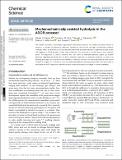Files in this item
Mechanomechanically assisted hydrolysis in the ADOR process
Item metadata
| dc.contributor.author | Rainer, Daniel Nikolaus | |
| dc.contributor.author | Rice, Cameron Mark | |
| dc.contributor.author | Warrender, Stewart James | |
| dc.contributor.author | Ashbrook, Sharon E. | |
| dc.contributor.author | Morris, Russell Edward | |
| dc.date.accessioned | 2020-06-26T16:30:02Z | |
| dc.date.available | 2020-06-26T16:30:02Z | |
| dc.date.issued | 2020-06-15 | |
| dc.identifier | 268530452 | |
| dc.identifier | dd90ca83-fa60-430a-b6d9-bcb0148dd0d9 | |
| dc.identifier | 85088242245 | |
| dc.identifier | 000548733200010 | |
| dc.identifier.citation | Rainer , D N , Rice , C M , Warrender , S J , Ashbrook , S E & Morris , R E 2020 , ' Mechanomechanically assisted hydrolysis in the ADOR process ' , Chemical Science , vol. Advance Article . https://doi.org/10.1039/D0SC02547J | en |
| dc.identifier.issn | 2041-6520 | |
| dc.identifier.other | ORCID: /0000-0001-7809-0315/work/76386740 | |
| dc.identifier.other | ORCID: /0000-0002-4538-6782/work/76386800 | |
| dc.identifier.uri | https://hdl.handle.net/10023/20165 | |
| dc.description | Funding: UK EPSRC (grant: EP/N509759/1) for funding of this work. D.N.R. also thanks the RSC for a Researcher Mobility Grant (no. M19-7166). R.E.M. is funded by the ERC Advanced Grant (787073 ADOR) and acknowledges the Charles University Centre of Advanced Materials (CUCAM) (OP VVV Excellent Research Teams, project number CZ.02.1.01/0.0/0.0/15_003/0000417). | en |
| dc.description.abstract | The ADOR (Assembly-Disassembly-Organisation-Reassembly) process for zeolites has been shown to produce a number of previously unknown frameworks inaccessible through conventional synthesis methods. Here, we present successful mechanochemically assisted hydrolysis of germanosilicate zeolite UTL leading to ADOR products under mild conditions, low amounts of solvent and in short reaction times. The expansion of zeolite synthesis into the realm of mechanochemistry opens up feasible pathways regarding the production of these materials, especially for industrial purposes, as well as an exciting application for economical enrichment of materials with the low natural abundance NMR-active isotope of oxygen, 17O. The results from mechanochemically assisted hydrolysis differ from those seen in the traditional ADOR approach: differences that can be attributed to a change in solvent availibility. | |
| dc.format.extent | 10 | |
| dc.format.extent | 1712712 | |
| dc.language.iso | eng | |
| dc.relation.ispartof | Chemical Science | en |
| dc.subject | QD Chemistry | en |
| dc.subject | NDAS | en |
| dc.subject.lcc | QD | en |
| dc.title | Mechanomechanically assisted hydrolysis in the ADOR process | en |
| dc.type | Journal article | en |
| dc.contributor.sponsor | European Research Council | en |
| dc.contributor.institution | University of St Andrews. School of Chemistry | en |
| dc.contributor.institution | University of St Andrews. EaSTCHEM | en |
| dc.identifier.doi | 10.1039/D0SC02547J | |
| dc.description.status | Peer reviewed | en |
| dc.identifier.grantnumber | 787073 | en |
This item appears in the following Collection(s)
Items in the St Andrews Research Repository are protected by copyright, with all rights reserved, unless otherwise indicated.

